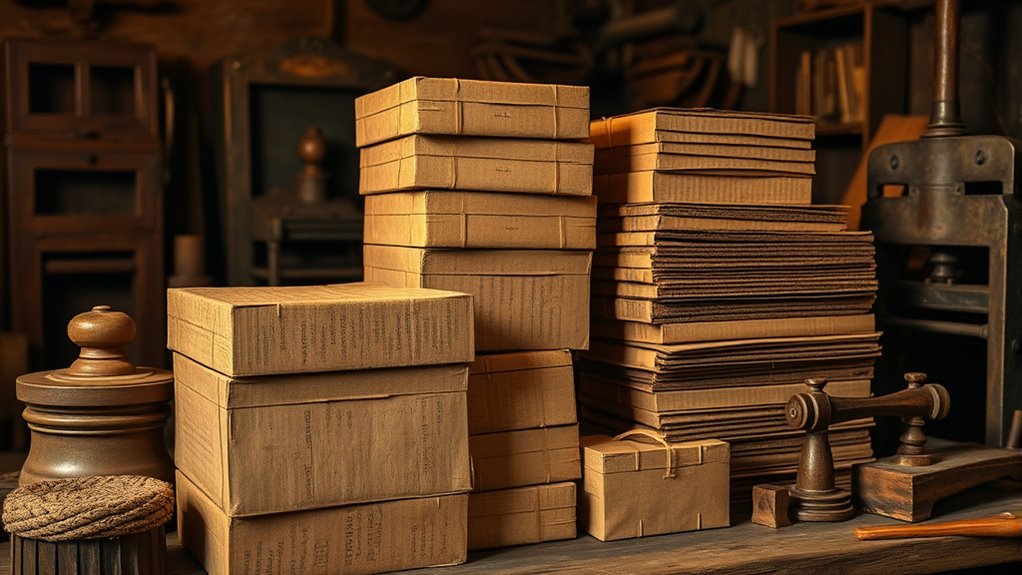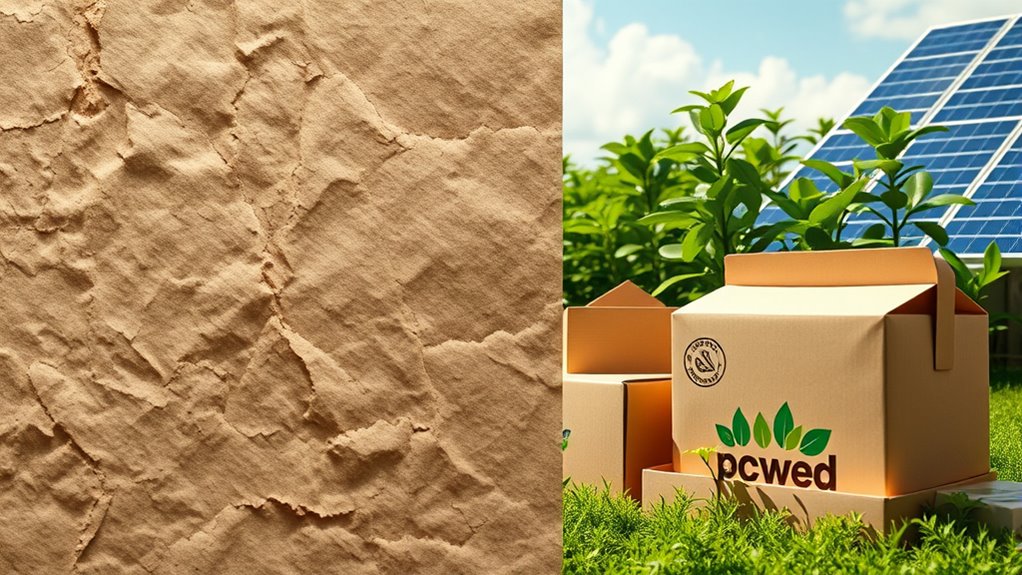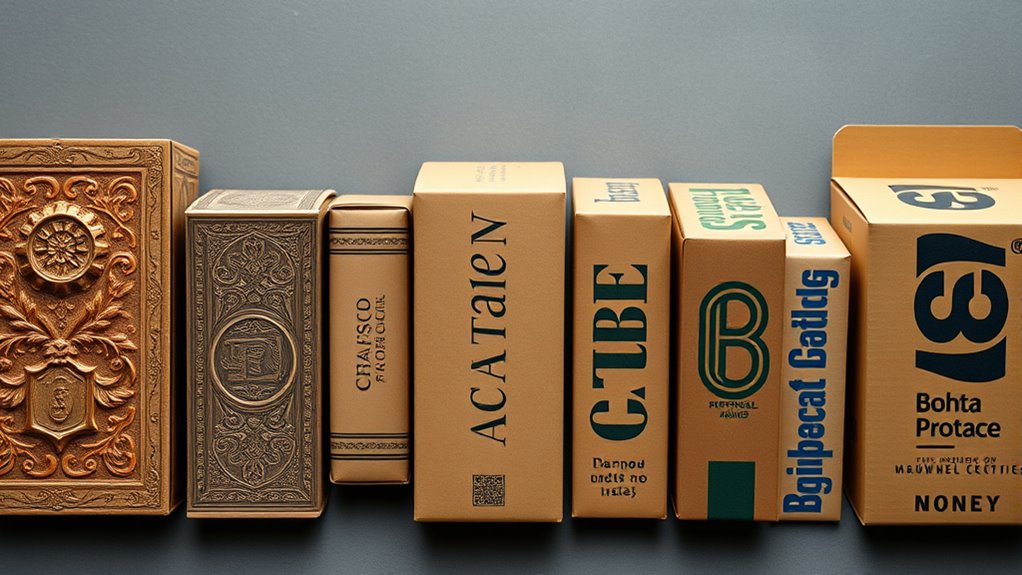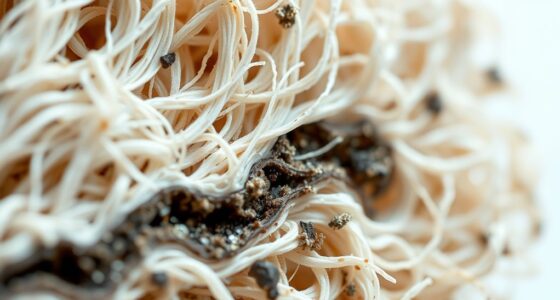Since the 1800s, cardboard has transformed from a simple packaging material into a versatile and innovative resource. Advances in manufacturing, robotics, and printing have expanded its use into arts, architecture, and eco-friendly technologies. Today, sustainable practices and smart features like sensors are shaping its future. If you keep exploring, you’ll discover how this everyday material is becoming a high-tech, eco-conscious solution across many industries.
Key Takeaways
- Cardboard originated in the 1800s for packaging, evolving into artistic, advertising, and structural applications over time.
- Manufacturing innovations, including automation and robotics, improved production efficiency, quality, and versatility.
- Sustainable practices emerged with biodegradable fibers like recycled materials, plant-based fibers, and eco-friendly coatings.
- Modern printing and design techniques, such as digital printing and holographic effects, expanded cardboard’s aesthetic and functional uses.
- Future trends focus on smart, eco-conscious solutions with integrated sensors, lightweight structures, and high-tech applications.
Origins and Early Uses of Cardboard in the 19th Century

Have you ever wondered how cardboard first came into being? In the 19th century, its historical significance grew as industries recognized its potential. Initially, cardboard was used for packaging and protective covers, offering a lightweight yet durable alternative to traditional materials. Its affordability and versatility made it attractive to manufacturers and consumers alike. Over time, the cultural adoption of cardboard expanded beyond practical uses, becoming part of everyday life—think of early advertising displays and artistic projects. This period marked the beginning of cardboard’s transformation from simple material to an essential element in commerce and communication. The development of manufacturing techniques during this era further propelled the widespread use of cardboard, especially as innovations in cutting and folding methods improved its efficiency and application. Additionally, advancements in mass production processes allowed for greater scalability and consistency in cardboard products.
Technological Advancements and Manufacturing Innovations

You’ll see how automation has revolutionized cardboard production, making it faster and more consistent. New eco-friendly materials are also emerging, reducing environmental impact without sacrificing quality. Additionally, advanced printing techniques now allow for sharper, more detailed designs, enhancing the versatility of cardboard products. The adoption of industry trends and regional manufacturing insights has further optimized production processes and supply chain efficiency. Furthermore, innovations in manufacturing technology have contributed to increased production speed and product durability. Emphasizing cost-cutting strategies can also help companies improve profitability while maintaining quality standards. Moreover, implementing security measures in production and supply chains can help prevent fraud and ensure product integrity.
Automated Production Processes
Advancements in automation have revolutionized the production of cardboard, making manufacturing faster, more consistent, and cost-effective. Automated production lines now handle tasks that once required manual effort, reducing errors and increasing output. Process automation integrates machinery such as robotic arms, sensors, and computer-controlled systems to streamline each step, from pulping to finishing. With these innovations, you experience shorter production cycles and improved quality control, ensuring each sheet meets strict standards. Automated systems also allow for real-time monitoring and adjustments, minimizing waste and downtime. As a result, manufacturers can meet higher demand efficiently while maintaining affordability. This shift to automated production processes marks a significant leap forward, transforming cardboard manufacturing into a highly efficient and reliable industry. High customer ratings for performance and reliability further demonstrate the success of these technological advancements. Implementing automated production has also decreased labor costs and enhanced safety protocols within factories. Furthermore, the integration of advanced robotics has increased precision and throughput in manufacturing operations. Additionally, the adoption of sensor technology allows for more precise quality assurance during each stage of production. The continuous improvement in automation technology ensures ongoing efficiency gains and quality enhancements across the industry.
Eco-Friendly Material Development
Building on the efficiency gains from automation, researchers and manufacturers are now focusing on developing eco-friendly materials for cardboard production. You can expect innovations that prioritize biodegradable options and renewable sourcing, reducing environmental impact. These advancements include plant-based fibers and recycled materials that break down naturally, helping to lessen waste. Additionally, the use of sustainable sourcing ensures that raw materials are obtained responsibly, further supporting environmental goals. Manufacturing methods are evolving to incorporate sustainable practices, making production more eco-conscious. Incorporating cost-effective solutions can further enhance the viability and adoption of these eco-friendly materials. Furthermore, innovations in advanced manufacturing techniques are improving the overall quality and durability of eco-friendly cardboard options, encouraging wider adoption and supporting environmental sustainability. Additionally, adopting sustainable practices in manufacturing can significantly reduce the carbon footprint associated with production processes.
Advanced Printing Techniques
As printing technology evolves, manufacturers are adopting innovative techniques that enhance both quality and efficiency. Digital printing allows for high-resolution images, vibrant colors, and quick setup, enabling customized designs and shorter production runs. This technology reduces waste and accelerates the manufacturing process. Holographic effects are also gaining popularity, adding a striking three-dimensional appearance to packaging. These effects catch the eye and create a premium look, making products stand out on shelves. With these advanced printing techniques, you can now incorporate intricate details, metallic finishes, and unique textures that were previously difficult or costly to produce. Additionally, ethical hacking techniques are employed in the security of digital printing systems to prevent unauthorized access and protect intellectual property. Ensuring the security of digital files is essential as digital workflows become more complex and interconnected. Implementing cybersecurity measures helps safeguard sensitive design data from potential threats. Integrating AI-driven insights into the design process further enhances creative possibilities and ensures that packaging appeals to target audiences. Moreover, understanding the latest manufacturing innovations can help companies stay competitive in a rapidly evolving market. Together, digital printing and holographic effects push the boundaries of cardboard design, offering more creative possibilities and better visual appeal to meet modern market demands.
Diversification Into New Industries and Applications

The versatility of cardboard has led to its rapid expansion into new industries and applications, beyond traditional packaging. In industrial settings, you’ll find it used for insulation, structural supports, and even temporary partitions. Its strength and lightweight nature make it ideal for prototypes and custom fixtures. Artists and designers also embrace cardboard for artistic experimentation, creating sculptures, installations, and innovative furniture. Its affordability encourages experimentation without significant investment, making it accessible for creative projects. Additionally, cardboard’s recyclability and ease of manipulation support sustainable practices across various sectors. As you explore these new uses, you’ll notice how its adaptability continues to drive innovation, proving that this humble material can serve far more purposes than originally imagined.
Environmental Impact and the Rise of Sustainable Practices

You can see how recycling and reuse are transforming the cardboard industry, reducing waste and conserving resources. Companies are now adopting eco-friendly materials to lessen environmental impact and meet sustainability goals. These practices are shaping a greener future for cardboard, making it more sustainable than ever before.
Recycling and Reuse
Focusing on recycling and reuse, the environmental impact of cardboard has become a central concern in promoting sustainable practices. You can participate in recycling initiatives by sorting your cardboard properly, ensuring it gets processed efficiently. Reuse strategies also help reduce waste; for example, repurposing boxes for storage or crafts extends their life. To maximize environmental benefits, consider these steps:
- Support local recycling programs to increase cardboard recovery rates.
- Opt for reusable packaging options instead of single-use cardboard containers.
- Educate others about the importance of recycling initiatives and reuse strategies.
Eco-Friendly Materials
As awareness grows about the environmental impact of traditional cardboard, many manufacturers are turning to eco-friendly materials to reduce their footprint. You now see innovations like biodegradable fibers and plant-based composites replacing conventional pulp. These materials break down naturally, minimizing waste and pollution. Companies are adopting sustainable practices by using renewable resources to produce packaging that’s both strong and eco-conscious. The table below highlights some key eco-friendly materials shaping the future of cardboard:
| Material | Benefits | Challenges |
|---|---|---|
| Biodegradable fibers | Decompose quickly, reduce waste | Cost and availability |
| Plant-based composites | Renewable, lightweight | Durability concerns |
| Bamboo pulp | Fast-growing, strong | Processing complexity |
| Sugarcane bagasse | Abundant, eco-friendly | Limited structural strength |
| Hemp fibers | Durable, biodegradable | Supply chain issues |
Modern Innovations: From Packaging to Artistic and Architectural Uses

In recent years, innovative uses of cardboard have expanded far beyond traditional packaging, transforming it into a versatile material for artistic and architectural projects. You’ll see how biodegradable coatings enhance sustainability in large-scale constructions and how smart packaging integrates technology for improved functionality. For example:
- Artists craft intricate sculptures and installations, pushing cardboard’s artistic boundaries.
- Architects develop lightweight, eco-friendly structures using layered and reinforced cardboard.
- Companies implement smart packaging featuring sensors and tracking, making shipping more efficient and eco-conscious.
These advancements allow cardboard to serve multiple roles, combining sustainability with innovation. The integration of biodegradable coatings guarantees environmental friendliness, while smart packaging demonstrates its adaptability to modern technological needs, opening new horizons for this humble material.
The Future of Cardboard: Trends and Emerging Technologies

The innovative uses of cardboard in art, architecture, and smart packaging have paved the way for exciting developments on the horizon. Future trends focus on sustainability, with biodegradable coatings making cardboard more eco-friendly and reducing waste. These coatings enhance durability while ensuring the material breaks down naturally, aligning with environmental goals. Smart packaging is also gaining traction, integrating sensors and digital features that improve product tracking and freshness. You’ll see more brands adopting these technologies to create interactive, sustainable solutions. Emerging innovations aim to make cardboard lighter, stronger, and more adaptable, opening new possibilities for applications across industries. As these trends evolve, cardboard will continue transforming from a simple material into a high-tech, sustainable resource for the future.
Frequently Asked Questions
How Did the Invention of Corrugated Cardboard Revolutionize Shipping?
The invention of corrugated cardboard revolutionized shipping by enabling better packaging innovation, making containers stronger yet lighter. You’ll notice how it improves the supply chain impact by reducing costs, preventing damage, and increasing efficiency. Corrugated cardboard’s durability and affordability transformed how goods are transported worldwide, allowing for safer, more reliable deliveries. Its widespread adoption has made shipping faster, more economical, and adaptable to various products, fundamentally changing the logistics industry.
What Are the Most Eco-Friendly Methods of Cardboard Recycling Today?
Your quest for eco-friendly cardboard recycling methods is like searching for a needle in a haystack of options. Today, sustainable practices lead the way, emphasizing reuse, composting, and closed-loop systems. Recycling innovations like chemical-free processes and enhanced sorting technology minimize environmental impact. By choosing these methods, you help reduce waste and conserve resources, making a significant difference in protecting our planet for future generations.
How Does Biodegradable Cardboard Compare in Durability to Traditional Types?
Biodegradable cardboard offers a decent biodegradable strength, but it generally falls short in durability comparison to traditional cardboard. You might notice it’s less resistant to moisture and rough handling, making it suitable for short-term uses. If you prioritize eco-friendliness, biodegradable options are great, but for long-term durability, traditional cardboard still outperforms. Consider your needs carefully when choosing between eco-friendly and conventional materials.
Are There Any Health Concerns Associated With Recycled Cardboard Materials?
You might be surprised to learn that about 70% of recycled cardboard is safe for use, but concerns remain. Recycled materials can contain chemicals from previous uses, raising questions about chemical safety and allergen risks. While most recycled cardboard is processed to reduce these hazards, some may still contain trace chemicals. It’s wise to check for certifications ensuring safety, especially if you have sensitivities or allergies.
What Are Innovative Architectural Projects Utilizing Large-Scale Cardboard Structures?
You might find innovative architectural projects using large-scale cardboard structures fascinating, especially in sustainable design. Many designers create impressive temporary installations that showcase cardboard’s versatility and eco-friendliness. These projects often emphasize sustainability, using recyclable materials for temporary art displays, pavilions, or exhibitions. Such structures demonstrate how cardboard can be a practical, eco-conscious choice for large-scale architecture, inspiring future developments in sustainable design and eco-friendly construction methods.
Conclusion
As you’ve seen, the evolution of cardboard reflects the adage, “necessity is the mother of invention.” From humble beginnings to innovative uses today, you can appreciate how each development shapes a more sustainable and creative future. Embrace the ongoing innovations, knowing that with every fold and fold-out, cardboard continues to surprise and serve you in ways you might never have imagined. The journey’s just beginning—what’s next is up to you.










